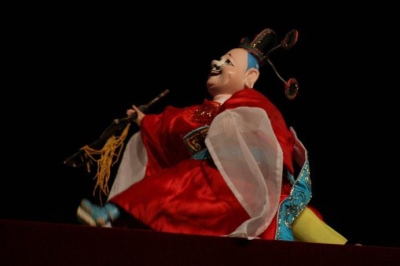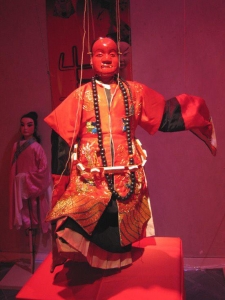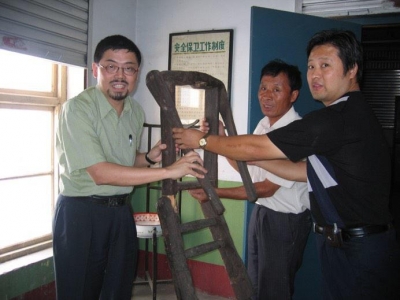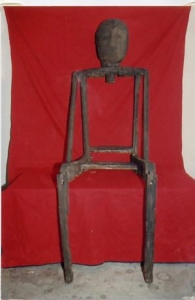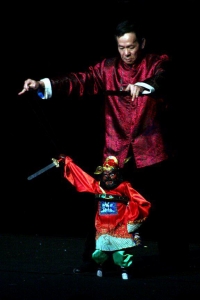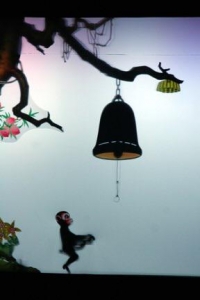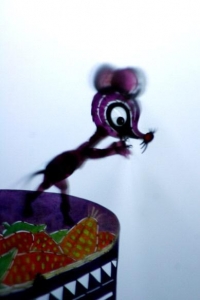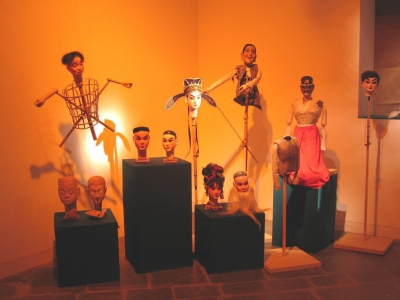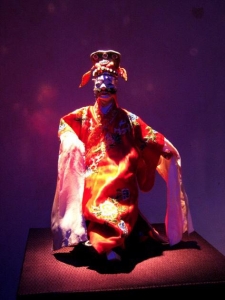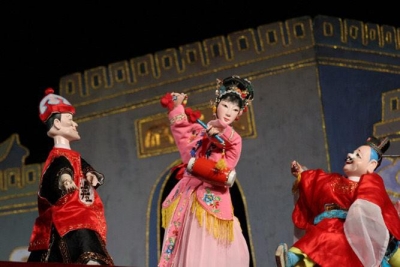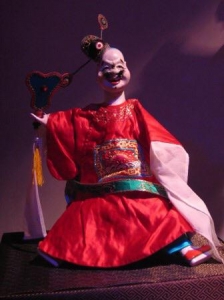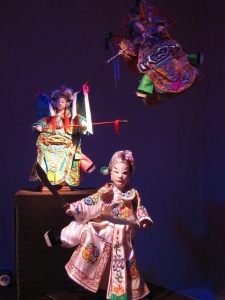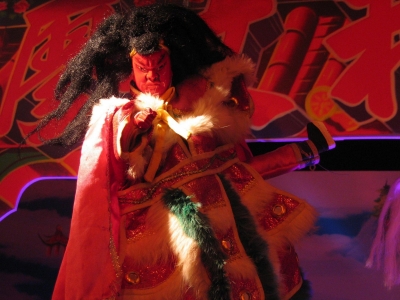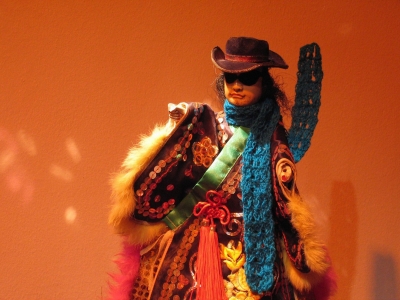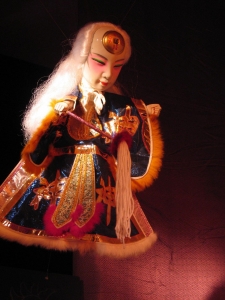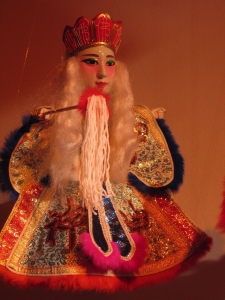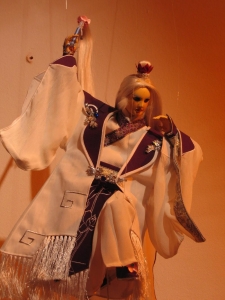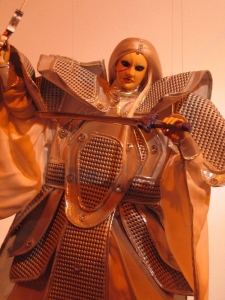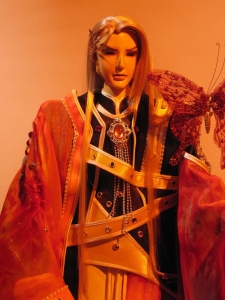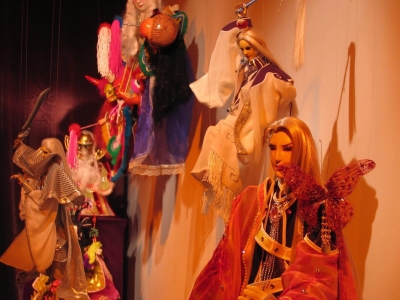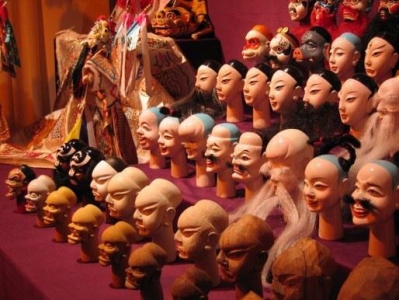文:王添強 17/8/2020
布袋木偶是二千年歷史的年輕品種 The glove puppet is a young species with a history of two thousand years in China
(Please roll down for English)
為了應對印度 Panchalika 雜誌的約稿,專門撰寫一篇關於中國「布袋木偶」發展歷史的文章,希望同時以中文與英文供大家分享。
布袋木偶是年輕的中國木偶品種,到十四世紀中葉才出現,與已經有兩千年歷史的中國提線木偶及皮影,的確有點年月的距離。中國木偶的歷史要追溯到公元前二百年之前,陪葬文化發展有所改變,由於下一代人才不足,大部分領袖不再使用真人陪葬,而改用草人,陶瓷人及木頭人作替身。這個二千年前陪葬文化改變就是木偶製作的開端。後來為求更似真人,所以加入關節及操控的線索,因此木偶活動起來,成為葬禮重要的儀式。
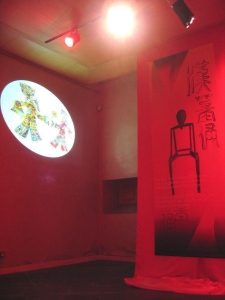
葬禮上的木偶與巫術的影子 The puppet at the funeral, the shadow of witchcraft, is the beginning of the puppet and the shadow
提線木偶至今依舊遺留祭祀的作用 The marionette still has a sacrificial role
公元前202年開始的漢朝,木偶由陪葬品變成儀式動作發展的同時,皮影戲也開始發展。這個今天的表演藝術,當初只是一個神秘的巫術,用影子給大家與死去的親人接觸。巫師在幕後,煙霧、燈光及音樂的幫助下,把親人帶到與死者相似的影子前,進入永別儀式,以開解大家對親人離世的悲傷。文獻上記載連漢武帝也有參與這個儀式。漢朝的四百年歷史當中木偶始終陪葬者的替代品,而皮影戲則是巫術的魔法。宮廷到民間主要娛樂,還是以歌舞表演、面具劇場及雜技為主。
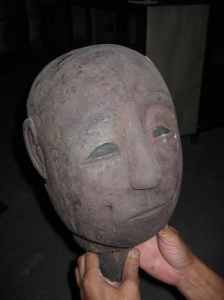
漢朝墓坑出土木俑頭部 Puppet head unearthed from a tomb in the Han Dynasty
漢朝木俑已經有關節以便活動 The puppets of the Han Dynasty have joints for movement
漢朝的木俑應該是偶木製作的開始 Han Dynasty is the beginning of puppet making
提線木偶由祭祀邁向娛樂 Marionettes move from sacrifice to entertainment
木偶與皮影戲在娛樂事業邁出重要一步
到公元581年開始的隋唐兩朝盛世,木偶也有很大進步,機械木偶及雜技木偶表演開始成為宮廷及貴族的重要娛樂。葬禮的提線木偶也開始發展成葬禮上表演,試圖減低親屬失去親人的傷痛。皮影戲也有了新任務,就是以人物剪影,在寺廟代替長捲軸及牆壁上的繪畫,進行宗教故事的宣講。因為佛教隨著之前一百多年,北方及西北游牧民族侵入中國中原地區,而大行其道。
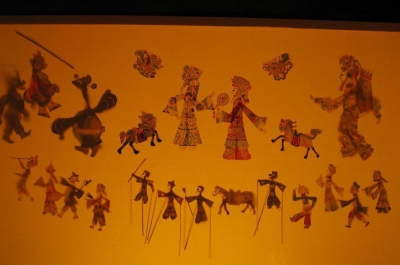
中國各地的不同皮影風格 Different shadow puppet styles across China
湖南的現代皮影 Modern shadow puppets in Hunan
湖南的現代皮影 Modern shadow puppets in Hunan
當佛教寺廟可以以皮影戲講解宗教教義,自然的發展,皮影戲也開始講述民間故事作為坊眾的娛樂。同時,木偶及皮影戲也隨著朝代的繁榮而得到發展,成為娛樂事業的一部分。手托木偶與提線木偶成為當時主力,當然還有皮影戲。而手托木偶還不是布袋木偶,而是杖頭木偶與布袋木偶的混合體會,十分像韓國傳統的木偶,及日本的最傳統木偶-人形淨琉璃 (Ningyō jōruri )。
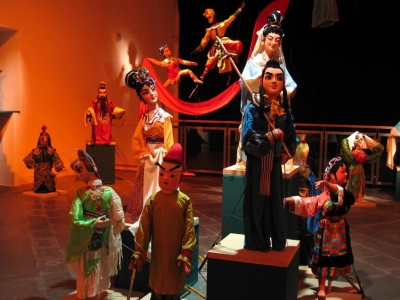
中國各地的不同風格的杖頭木偶 Rod puppets of different styles all over China
中國各地的不同風格的杖頭木偶 Rod puppets of different styles all over China
木偶與影子戲在娛樂事業得到輝煌發展
公元960年的宋朝,連續四百年的日子,雖然飽受不同北方民族的入侵,但短暫太平日子下商業貿易極為興盛。因為,牛皮燈籠的普及,使晚上市集成為朝流。因為晚上市集的流行,及商業活動的頻繁,使娛樂事業的需要大大增加,而且由貴族階級蔓延知民間各界。
各出奇謀,改善技術,創作吸引的故事,成為各劇場是否能爭奪觀眾的表現。於是,各劇場都開始創作自己的秘密特色,杖頭木偶,提線木偶,水木偶,皮影戲名顯絶技。不單成為成人娛樂,從遺傳文物中看到已經是孩童的玩具。
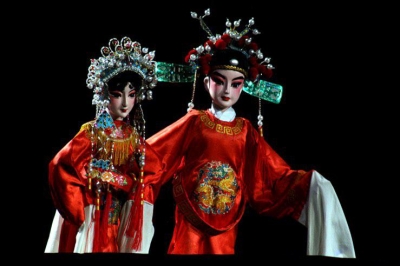
廣東杖頭木偶「帝女花」 Guangdong Rod Puppet "Princess's Flower"
十世紀蒙古人在中國的一百年統治,沒有改變這些逃避現實苦難的劇場娛樂事業,反而使集中在大都會的藝術向偏遠地區發展,成為很多當地風格的木偶及皮影戲,怎至有傳言,皮影戲更向中東地區蔓延。
布袋木偶終於在中國土地誕生
公元1368年的明朝,福建地方開始有明確的記載,布袋木偶在當地得到發展及流行。當然這是繼承過去四百年年,木偶用作講故事的傳統。這種傳統與流行在西班牙及中東地區一帶的巡迴木偶表演劇團,沒有太大分別,就是有人專門講故事,到關鍵表演位置木偶就會出場,另外有專門的樂手作伴奏。
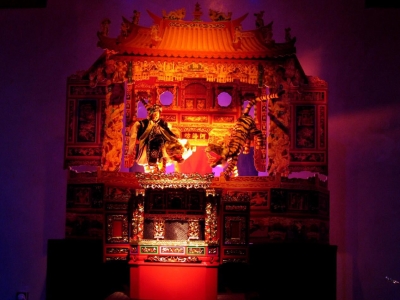
傳統的布袋木偶舞台 Traditional glove puppet stage
這種講故事的木偶劇場表演風格,與今天我們還可以看到的傳統越南水木偶,及韓國傳統木偶十分相似。但由於福建布袋木偶小巧輕盈,變化多端,可以進行很多神乎其技的表現。加上位置在中國沿海邊緣地區,就算經歷多年戰亂,布袋木偶傳統,還是得到好好保存。布袋木偶更傳播至中國各地,當然包括對岸的台灣。
布袋木偶近一百年的分離與發展
近一百年福建地區,布袋木偶成為當地的主要表演藝術,比提線木偶及皮影戲更受歡迎,無論婚禮,葬禮,節慶,出生滿月的日子,邀請布袋木偶在宴會上表演是必然動作。當時以福建人為主的台灣地區,當然也一樣發到影響,布袋木偶成為農村,鄉鎮人民的主要娛樂,特別是在節慶期間的廟宇廣場前的廟會,但布袋木偶始終是街頭藝術。
福建漳州的布袋木偶 Fujian glove puppet
福建漳州的布袋木偶 Fujian glove puppet
福建漳州的布袋木偶 Fujian glove puppet
在十九世紀近尾聲,台灣被日本吞併,成為殖民地。二戰前日本人很想利用布袋木偶進行政治宣傳。於是,一種稱為「皇民戲」的木偶劇場出現。
福建地區的布袋木偶五十年代,憑藉着倚傳統精湛的技巧,代表中國到歐洲表演,獲得西方國家的肯定。可惜在文化大革命中完全被停滯、冰封。
福建的布袋木偶由於這個自然發展的停止,使傳統至今得到原汁原味的保存。台灣方面在五十年代,由於國民黨政府害怕動亂,所以禁止所有街頭表演。這個進入劇場的發展,讓所有布袋劇團必須重新構思,要賣票的話,傳統街頭表演的劇目必須缺乏吸引力,一種以武術打鬥為主的布袋木偶劇場誕生,名為「金光木偶」。
台灣金光木偶 Golden Light Puppets
台灣金光木偶 Golden Light Puppets
台灣金光木偶 Golden Light Puppets
八十年代武打布袋木偶進軍電視螢光幕,九十年代發展成為今天台灣年輕人的錄像光碟寵兒「霹靂木偶」,還吸引大量日本、韓國的支持者。相同木偶傳統因為政治分隔,出現了很大的分別。
台灣霹靂木偶 Martial Arts Puppets
台灣霹靂木偶 Martial Arts Puppets
台灣霹靂木偶 Martial Arts Puppets
有七百年的布袋木偶在中國歷史還是很年輕
中國木偶走過二千年沒有間斷的歲月,年輕的布袋木偶也有七百年的發展,今天還在台灣社會上有龐大的市場價值,及充分活躍的生命力。中國布袋木偶未來的日子,與其所有歐洲及亞洲遠親一樣,不會容易克服潮流的壓力,不過可以確定,他與世界上所有布袋木偶一樣,成為活的歷史。
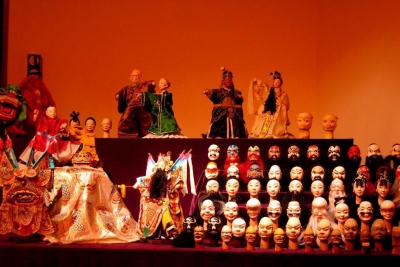
各個行當(生旦淨丑末)的布袋木偶頭 Glove puppet heads of different roles
各個行當(生旦淨丑末)的布袋木偶頭 Glove puppet heads of different roles
-----
Seven hundred years of art between fingers
By Simon Wong
The glove puppet is a young species in China
The glove puppet is a young Chinese puppet species, which did not appear until the middle of the 14th century. It is indeed a bit different from the 2,000-year-old Chinese puppet and shadow play.The history of Chinese puppetry dates back to before 200 BC when the funeral culture changed due to the shortage of talents. The leaders abandoned the tradition of human sacrifice but used figures made from grass, ceramic and wood. This change in funeral culture is the beginning of puppet making. Later, in order to make the figures be more like a living person, clues of joints and manipulation were added, so the puppets became lively and an important part of the funeral ceremony.
During the Han Dynasty that began in 202 BC, when puppets changed from funeral objects to ritual movements, shadow play also began to develop. This performing art today was only a mysterious witchcraft back then, using shadows to make contact with dead relatives. Behind the scenes, with the help of light, smoke, and music, wizards brought the deceased to the shadows as a farewell ceremony to relieve people’s grief for the loss of their loved ones. Records also show that even Emperor Wu of the Han Dynasty was involved. In the 400-year history of the Han Dynasty, puppets had always been a substitute for burialists, while shadow play was the magic of witchcraft. The main entertainment from the palace to the folk is still singing and dancing, mask theater and acrobatics.
Puppet and shadow play takes an important step in the entertainment industry
The peace and prosperity of the Sui and Tang dynasties began in 581 AD, puppetry also made great progress. Mechanical puppets and puppet acrobatics began to become important entertainments for the court and nobles. The funeral puppets also began to develop into funeral performances to reduce the family's sadness at the loss of loved ones. With the introduction and blooming of Buddhism following the invasion of the nomadic people from the North and Northwest to Central China 100 years ahead, the shadow play also had a new task, which was to replace the scrolls and the paintings on the walls with the silhouettes of the characters in the shadow play to promote Buddhist religious stories.
When Buddhist temples can use shadow play to explain religious doctrines, it is natural to develop shadow play and begin to tell folk stories as entertainment for the public. At the same time, puppets and shadow plays also developed with the prosperity of the dynasty and became part of the entertainment industry. At that time, hand-held puppets and string puppets became the main force, and of course there were shadow plays. The hand-held puppets were not glove puppets, but a mix of rod puppets and glove puppets, which were very similar to traditional Korean puppets and Japan's most traditional puppet-Ningyō jōruri.
Puppets and shadow play have developed brilliantly in the show businesses
In the Song Dynasty in 960 AD, for 400 consecutive years, despite the invasion of different northern nations, commercial trade flourished during the short period of peace. The popularity of cowhide lanterns made going to the evening market a popular social event. Thanks to the popularity of evening markets and frequent commercial activities, the need for entertainment had greatly increased, and the aristocracy spread to all walks of life.
Ingenuity, technology, attractive stories then determined whether a theater was competitive enough to draw the audience. As a result, theaters began to create their own secret features: rod puppets, string puppets, water puppets, and shadow play. Not only had it become adult entertainment, it also became a children's toy as seen from genetic relics.
The 100-year rule of the Mongols in China in the 10th century did not change the fact that theater entertainment was a way to escape the suffering in reality. Instead, the arts that were concentrated in the metropolis spread to remote areas and developed into puppets and shadow plays with local style. Some also say that shadow plays spread to the Middle East at this time.
The glove puppet was finally born in China
There were clear records that in the Ming Dynasty in 1368 AD, glove puppets were popular in Fujian. The technique of puppetry had changed, but of course it still inherited the same tradition of puppetry used for storytelling over the past 400 years. This tradition is not much different from the touring troupes that are popular in Spain and the Middle East, with storytellers telling stories, puppets performing at key moments and musicians playing music.
This story-telling puppet theater performance style is very similar to the traditional Vietnamese water puppets and Korean traditional puppets that we can still see today. But because the Fujian glove puppets are small, light, and varied, they can perform a lot of amazing skills. Fujian is located in the coastal area of China, therefore even after years of war, the tradition of glove puppets is still well preserved. Glove puppets have spread to all parts of China, including of course Taiwan on the other side.
Glove puppets have separated and developed
In the past 100 years in Fujian, glove puppets have become the main local performing arts. They are more popular than string puppets and shadow shows. No matter weddings, funerals, festivals, or the day of the baby’s birth, it is inevitable to invite glove puppets to perform at banquets. At that time, the Taiwan region, which was dominated by Fujianese people, was certainly the same. Glove puppets became the main entertainment of people of both rural areas and in towns, especially in the square in front of temples during festivals, but glove puppets were always street art.
At the end of the 19th century, Taiwan was taken by Japan and became a colony. The Japanese wanted to use glove puppets as political propaganda. Thus, a theater called "Japanese Emperor Citizen Puppets" appeared.
In the 1950s, the glove puppets from the Fujian region, well known for its traditional and exquisite skills, performed in Europe as a representative of China, and were affirmed by Western countries. Unfortunately, development was completely frozen during the Cultural Revolution.
Due to the cessation of natural development of Fujian glove puppets, the tradition has been preserved so far. In Taiwan in the 1950s, the Kuomintang government banned all street performances out of fear of social unrest. The need to move to theaters led to a thought that traditional street performances must be made less attractive so that they could sell their tickets. A glove puppet theater based on martial arts combat was then born -- "Golden Light Puppets."
In the 1980s, the martial arts glove puppets entered the TV screen and became the video DVD darling of today's young people in Taiwan. They also attracted a large number of supporters from Japan and South Korea. The same tradition then appeared to be different because of the political separation.
The glove puppet has been in China for 700 years but is still very young
Chinese puppets have gone through two thousand years uninterrupted, and the young glove puppets have been developed for 700 years. Today they still have a huge market value and full vitality in Taiwanese society.The future of the Chinese glove puppet, like all its distant relatives in Europe and Asia, will not easily overcome the pressure of the trend, but it is certain that he, like all the puppets in the world, will become a living history.


